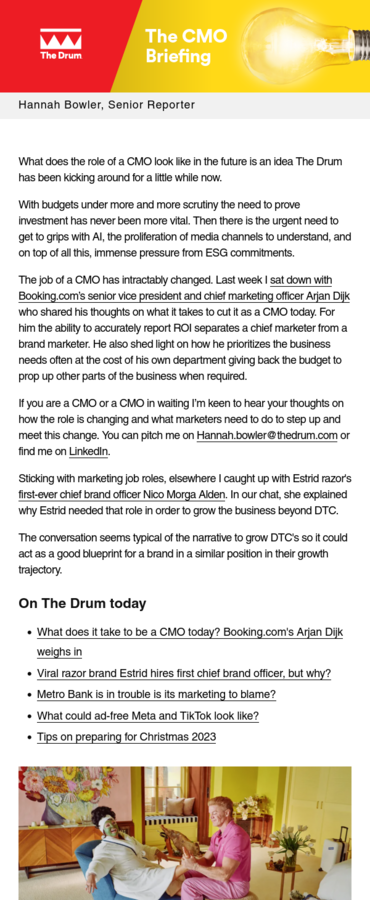How to create a stunningly successful B2B content strategy in 2023
For The Drum's Content Marketing in Focus, Margo Waldrop helps guides B2B content marketers on how to write good content, and how to build a successful content strategy in 2023.

Building good content strategy / Airfocus/Unsplash
Creating a well-organized B2B content strategy is the only way to survive in an already saturated market of content. Yes, it’s quite easy to throw out blog posts, webpages and the like, but what isn’t easy is having a plan where all your content connects in a way that makes sense to your intended customer and leads them your way. Without this game plan, you are not only wasting your company’s time, but your intended customers’ as well. The purpose of content, whether it’s in the B2B or B2C space is to:
- educate
- guide
- support
- benefit
In other words, create brand awareness, credibility, and nurture your target audience, which takes planning and most importantly structure.
How do you write good B2B content?
Connecting with your B2B audience depends on two things: what is your content, and where is your content. In fact, a 2020 survey conducted by the Content Marketing Institute showed that 71% of B2B marketers agree that prioritizing relevant content where a person is most likely to view it, should be a top focus.
The content businesses create has traditionally consisted of talking about your company and what you offer, however, that is shifting as companies realize that even with B2B, you must connect emotionally in some way. After all, human beings run companies. They have emotions that prompt the reasons for what they do, and reasons for decisions. So, learning to write content that not only imparts the benefits you provide, but also understands the ‘why’ of a customer will ultimately lead to your success. The same report revealed that 50% of respondents were unsuccessful in creating content that addresses the customer’s needs, instead of their own self-promotion. That is a relevant gap that must be closed.
Advertisement
It’s also important to know exactly where your content needs to be. Choosing channels just to communicate with your intended targets isn’t enough. They want to see that you exist in the space of their targeted customers as well. This makes it easier for them to connect with you and understand that you ‘get’ them. Simple, fast, emotive connections done properly.
LinkedIn has recently kicked off a campaign denoting that very reasoning. They have taken the ‘mundane’ out of B2B marketing and added a much-needed sense of understanding for their target audience. With their debut of new products and tools to assist B2B marketers, they have chosen themselves as the channel to connect with people who appreciate it best. They’ve deftly matched the content with the channel. Win. Win.
What are examples of B2B content?
There are several leading methods for sharing your content in the B2B space. So many so, that focusing on the channels that work best for your brand, is always your best bet. However, incorporating new ways to communicate with potential and past customers is a great way to build trust and loyalty. And trust and loyalty are what bring repeat business, something vital for company growth. Tackle what works best first, improve upon it, and then move up to another method. If done with intent and a well-defined structure, you will win the B2B marketing game.
SEO-focused content
Companies who do business with other companies do their research, and in a big way. It’s not enough to have a website for them to look at, they want to see that you rank in your areas of expertise. SEO driven content is your way to go. Research, keywords, internal links, back links, and intentional content are the best methods of gaining SEO traction. Put in the work and make sure that whatever content you are publishing is top of the line, and puts you head and shoulders above the rest.
Advertisement
Case studies
It’s not enough to state that you are the best, you have to prove it. Case studies are a great way to do that, whether they are on your website, white papers, or email, make sure you have the proof of your successes. When you write case studies, remember to make it about the subject of the study and not your company. Impart how their company improved and benefited from working with your brand, and why they chose you. Potential customers need to understand how they will benefit from a relationship with your company and if you are worth their while.
Video
It’s important to remember that people run companies. They will make the decisions to do business with you, or not, so finding a way to connect with them is important. Video can do that, especially if you take time to show the people within your company. Create a video tour of your production line, or the CEOs and why they started the company in the first place. Write a great script that has both emotions and benefits. Get to know your intended customers by letting them get to know you. Video ranks highly, so finding a way to incorporate video into your marketing will help bump you to the top.
Suggested newsletters for you
Educational base
Securing a wealthy account may fund your business, but it’s also important that you help the businesses who need it. This builds trust and is a vital cog in your wheel. Post tutorials, guides, or ‘how to’s, to not only show your expertise but also lead brands on a learning journey that ends with your company.
Newsletters
In the past, newsletters have gotten a bad rap for being boring and unimportant, but that doesn’t have to be the case. They keep you top of mind, especially when done consistently. They are an excellent way to communicate information to your current customers, as well as to potential customers. Make sure to write them in a style that best represents your brand, and imparts the benefits of working with you, albeit in a subtle, informational way. Remember to take out the ‘boring’ and include the ‘conversational’. This aids retention for the readers and helps strengthen your bond.
Social media
We can’t forget the impact that properly used social media can have on your b2b relationships. Whether your posts get 1 million likes, or only five, it’s important that companies know you exist and that you aren’t going anywhere. A potential customer does their homework and checks out your company’s social media channels, they want to see you know how to connect, and that you actually serve a purpose beyond trying to increase profits. Vary your posts and make sure to post customer wins as well as your own. Readers like to see people triumph, whether that is a company or just the cashier in your brick-and-mortar store.
The above list is only the tip of the iceberg. There are many ways to reach out and connect with customers. Seminars, white papers, and downloadable guides are all additional opportunities to share content. And yes, they all require written content, but if you are keeping your customers’ needs in mind and have nailed down your brand voice, then it isn’t overly difficult. It is the matching of the proper channel with the proper content that constitutes a successful B2B content strategy. A prosperous match made in B2B heaven.
Don’t miss out on The Drum Plus for more B2B marketing tips. Sign up now.
Visit The Drum's Content Marketing in Focus hub for more news, insights, and strategies around content marketing.

